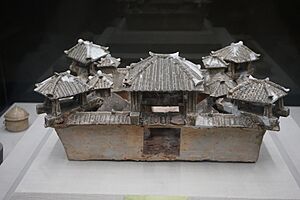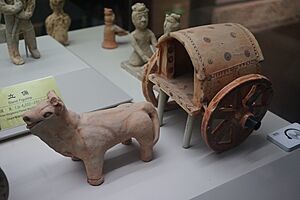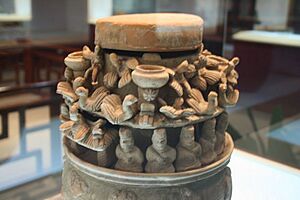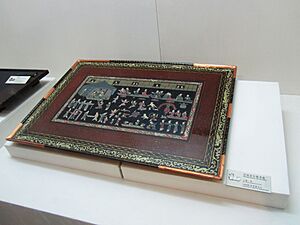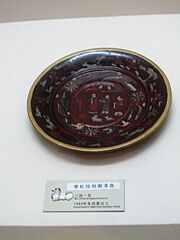Eastern Wu facts for kids
Quick facts for kids
Wu
吳
|
|||||||||
|---|---|---|---|---|---|---|---|---|---|
| 222–280 | |||||||||
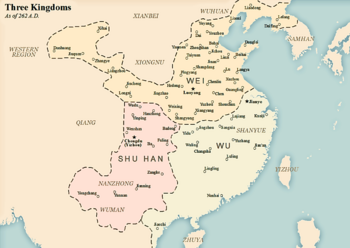
The territories of Wu (in light greenish grey), as of 262 A.D.
|
|||||||||
| Capital | Wuchang (222–229, 265–266) Jianye (229–265, 266–280) |
||||||||
| Common languages | Eastern Han Chinese, Old Wu Chinese | ||||||||
| Religion | Taoism, Confucianism, Chinese folk religion | ||||||||
| Government | Monarchy | ||||||||
| King (222–229) Emperor (229–280) |
|||||||||
|
• Nov 222 – May 252
|
Sun Quan | ||||||||
|
• May 252 – Nov 258
|
Sun Liang | ||||||||
|
• Nov 258 – Sep 264
|
Sun Xiu | ||||||||
| Historical era | Three Kingdoms | ||||||||
|
• Independence from Cao Wei
|
222 | ||||||||
|
• Sun Quan declaring himself Emperor
|
229 | ||||||||
| 31 May 280 | |||||||||
| Population | |||||||||
|
• 238
|
2,567,000 (disputed) | ||||||||
|
• 280
|
2,535,000 (disputed) | ||||||||
| Currency | Chinese coin, Chinese cash | ||||||||
|
|||||||||
| Today part of | |||||||||
|
Tanner (2009) estimates the Wu population to be about one-sixth of the Han population. This would be much more than the numbers given in 238 and 280, and could be because of census methods used in ancient China.
|
|||||||||
| Eastern Wu | |||||||||||||||||||||||||||||||||||
|---|---|---|---|---|---|---|---|---|---|---|---|---|---|---|---|---|---|---|---|---|---|---|---|---|---|---|---|---|---|---|---|---|---|---|---|
| Traditional Chinese | 東吳 | ||||||||||||||||||||||||||||||||||
| Simplified Chinese | 东吴 | ||||||||||||||||||||||||||||||||||
| Hanyu Pinyin | Dōng Wú | ||||||||||||||||||||||||||||||||||
|
|||||||||||||||||||||||||||||||||||
| Sun Wu | |||||||||||||||||||||||||||||
|---|---|---|---|---|---|---|---|---|---|---|---|---|---|---|---|---|---|---|---|---|---|---|---|---|---|---|---|---|---|
| Traditional Chinese | 孫吳 | ||||||||||||||||||||||||||||
| Simplified Chinese | 孙吴 | ||||||||||||||||||||||||||||
| Hanyu Pinyin | Sūn Wú | ||||||||||||||||||||||||||||
|
|||||||||||||||||||||||||||||
Wu (Chinese: 吳), also known as Eastern Wu or Sun Wu, was an ancient Chinese state. It was one of the three main states fighting for control of China during the Three Kingdoms period. Wu started as a kingdom under another state called Cao Wei in 220. But in November 222, it declared itself fully independent. Its first ruler, Sun Quan, became an emperor in May 229. This made Wu an empire.
The name "Wu" came from the area where it was located. This region, the Jiangnan area, was also called "Wu" in history. Historians call it "Eastern Wu" or "Sun Wu" to tell it apart from other states with similar names. It was called "Eastern Wu" because it controlled much of eastern China. It was called "Sun Wu" because its rulers belonged to the "Sun" family.
Wu's main capital was Jianye (which is Nanjing today). Sometimes, its capital was also at Wuchang (武昌; today's Ezhou, Hubei).
Contents
History of Eastern Wu
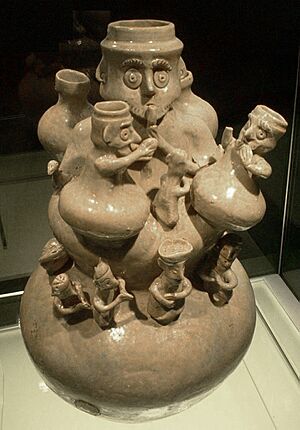
How Wu Began

Near the end of the Han dynasty, a warlord named Sun Ce started taking over lands. He was the older brother of Sun Quan. Between 194 and 199, Sun Ce conquered many areas in the Jiangdong and Wu regions. He later stopped supporting another warlord, Yuan Shu, who had declared himself emperor. This was seen as a betrayal of the Han emperor. The powerful warlord Cao Cao then gave Sun Ce the title "Marquis of Wu."
Sun Ce died in 200, and his younger brother, Sun Quan, took over. Sun Quan also showed loyalty to the Han emperor but ruled his lands independently. In 208, Sun Quan teamed up with another warlord, Liu Bei. Together, they defeated Cao Cao at the famous Battle of Red Cliffs. Their alliance lasted about ten years.
However, in 219, Sun Quan broke ties with Liu Bei. He sent his general Lü Meng to attack Liu Bei's lands in Jing Province. Liu Bei's general, Guan Yu, was captured and killed by Sun Quan's forces. After this, Sun Quan's territory grew to include the southern part of Jing Province.
In 220, Cao Cao's son, Cao Pi, ended the Han dynasty. He made himself emperor and started the state of Cao Wei. Sun Quan agreed to be a vassal king under Wei, called "King of Wu." A year later, Liu Bei also declared himself emperor and founded the state of Shu Han. In 222, Liu Bei attacked Sun Quan to get Jing Province back. But Liu Bei was badly defeated by Sun Quan's general Lu Xun at the Battle of Xiaoting.
Liu Bei's son, Liu Shan, and his helper, Zhuge Liang, later made peace with Sun Quan. Sun Quan declared full independence from Wei in 222. He ruled as "King of Wu" until 229. That year, he declared himself "Emperor of Wu." Shu Han recognized him as a true emperor.
Sun Quan's Long Rule
Sun Quan ruled for over 30 years. His long rule brought peace and stability to southern China. During his time, Wu fought many wars against Wei. These included battles at Ruxu (222–223), Shiting (228), and Hefei (234). Wu could not take land north of the Yangtze River. Wei also failed to conquer lands south of the Yangtze.
Later in his rule, Sun Quan's sons fought over who would be the next emperor. Sun Quan had made Sun He his heir. But Sun He had a rivalry with his younger brother, Sun Ba. This caused two groups to form in Sun Quan's court, each supporting a different son. Sun Quan eventually removed Sun He and made Sun Ba take his own life. Many officials who supported either son also faced bad outcomes. Sun Quan then chose his youngest son, Sun Liang, as the new heir.
Later Emperors and the Fall of Wu
Sun Quan died in 252. His son, Sun Liang, became emperor. Two powerful officials, Zhuge Ke and Sun Jun, helped him rule. In 253, Sun Jun killed Zhuge Ke. Sun Jun then held the real power in Wu. After Sun Jun died, his cousin, Sun Chen, took over. During Sun Liang's rule, two rebellions happened in Wei's territory. Wu forces tried to help the rebels, hoping to gain land. But both rebellions failed, and Wu lost many soldiers.
In 258, Sun Chen removed Sun Liang from power. He put Sun Xiu, another son of Sun Quan, on the throne. Later, Sun Xiu managed to kill Sun Chen with the help of his generals.
Sun Xiu died in 264. This was a year after Shu Han was conquered by Wei. Wu was having problems inside, with rebellions in the south. Officials decided to make Sun Hao, Sun He's son, the new emperor.
At first, Sun Hao lowered taxes and helped poor people. But he soon became cruel and focused on parties instead of ruling well. His harsh rule made many people angry. However, officials like Lu Kai and Lu Kang helped keep Wu somewhat stable.
In 266, a new dynasty called Jin took over from Cao Wei. In 279, Jin armies attacked Wu from many directions. Sun Hao tried to fight back, but Wu's armies were defeated. The Wu chancellor, Zhang Ti, was even killed in battle. Seeing that Wu was going to fall, Sun Hao surrendered to the Jin dynasty on May 31, 280. This marked the end of Wu and the end of the Three Kingdoms period.
Government and Military
Even though Sun Quan became emperor, Wu's government still felt like it was run by powerful warlords. At first, famous generals led the military. They earned their positions through their skills and bravery. These generals were known for being very independent.
Inside the court, powerful families often influenced politics. Important positions were passed down from parents to children. This was different from the Han dynasty, which had a system where people earned their jobs. Over time, the central government lost some power. Outside the court, families had their own authority. Sometimes, Wu was run to protect these specific families.
The Eastern Wu period was important for Vietnamese history. A ruler named Shi Xie in the Jiaozhou region (modern Vietnam and Guangzhou) is remembered as "the first Vietnamese." At first, the Vietnamese people were happy with Wu's rule. But when a general named Shi Hui rebelled against Wu, the Vietnamese fought him. However, when a Wu general killed Shi Hui and his whole family, the Vietnamese became very upset. In 248, people in some southern areas rebelled. Wu sent a general to calm them down. But the rebels regrouped under a leader named Lady Triệu. She marched on Jiaozhi but was defeated and took her own life.
Culture and Economy
Wu's culture grew strong under Sun Quan's rule (229 to 252). Many people moved from the north to Wu. Also, people from the Shanyue group settled there. This helped increase the number of workers and boosted farming. River travel also became very important. New canals were built, making transportation easier.
After the Battle of Xiaoting, trade between Shu Han and Wu restarted. Shu's cotton was very important for Wu. Industries like shipbuilding, salt production, and metalworking also grew a lot.
However, economic problems like inflation, which started in the Han dynasty, continued. Sun Quan tried to create a new currency of large copper coins. He also tried to stop people from making their own money. But this plan did not work well and was stopped in 246.
Eastern Wu also had close trade with countries like Vietnam and Cambodia. Wu even traded with India and the Middle East.
Legacy of Wu
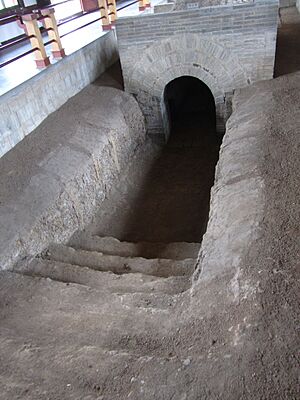
Under Wu's rule, the Yangtze River Delta region became a major center for trade, culture, and politics in China. Before this, it was seen as a wild "jungle." Wu's achievements in the south helped Chinese civilization spread to the furthest southern parts of the empire.
In 230, Chinese explorers from Wu reached an island called "Yizhou." Some historians think this was Taiwan, while others believe it was the Ryukyu Islands. Wu merchants might have also reached southern Vietnam and Cambodia.
Later in Wu's history, its once strong military became weak. It struggled to take the city of Hefei from Wei. This was made harder after Wei built a strong castle there. Wu also failed to help rebels against Wei in 255 and the late 250s. Wu forces arrived too late to help, and the rebellions were crushed. When a large rebellion broke out, Wu sent many soldiers to help. But they suffered a big defeat.
During the conquest of Shu by Wei in 263, Wu could not fully help its allies. This was because of a rebellion happening in Vietnam.
Wu's decline began after the death of Lu Xun in 245 and Sun Quan in 252. Sun Quan's later rulers could not do much for the empire. Corruption became a big problem in Wu. This made it easy for the Jin dynasty to conquer Wu in 280.
List of Sovereigns
| Temple name | Posthumous name | Family name (in bold) and personal name | Reign | Era names and their year ranges |
|---|---|---|---|---|
| Shizu | Emperor Wulie | Sun Jian | (N/A) | (N/A) |
| (N/A) | Prince Huan of Changsha | Sun Ce | (N/A) | (N/A) |
| Taizu | Emperor Da | Sun Quan | Nov 222– May 252 |
|
| (N/A) | (N/A) | Sun Liang | 252–258 |
|
| (N/A) | Emperor Jing | Sun Xiu | 258–264 |
|
| (N/A) | Emperor Wen | Sun He | (N/A) | (N/A) |
| (N/A) | Emperor Mo | Sun Hao | 264–280 |
|
Emperors' family tree
| Eastern Wu | |||||||||||||||||||||||||||||||||||||||||||||||||||||||||||||||||||||||||||||||||||||||||||||||||||||||||||||||||||||||||||||||||||||||||||||||||||||||||||||||||||||||||||||||||||||||||||||||||||||||||||||||||||||||||||||||||||||||||||||||||||||||||||||||||||||||||||||||||||||||||||||||||||||||||||||||||||||||||||||||||||||||||||||||||||||||||||||||||||||||||||||||||||||||||||||||||||||||||||||||||||||||||||||||||||||||||
|---|---|---|---|---|---|---|---|---|---|---|---|---|---|---|---|---|---|---|---|---|---|---|---|---|---|---|---|---|---|---|---|---|---|---|---|---|---|---|---|---|---|---|---|---|---|---|---|---|---|---|---|---|---|---|---|---|---|---|---|---|---|---|---|---|---|---|---|---|---|---|---|---|---|---|---|---|---|---|---|---|---|---|---|---|---|---|---|---|---|---|---|---|---|---|---|---|---|---|---|---|---|---|---|---|---|---|---|---|---|---|---|---|---|---|---|---|---|---|---|---|---|---|---|---|---|---|---|---|---|---|---|---|---|---|---|---|---|---|---|---|---|---|---|---|---|---|---|---|---|---|---|---|---|---|---|---|---|---|---|---|---|---|---|---|---|---|---|---|---|---|---|---|---|---|---|---|---|---|---|---|---|---|---|---|---|---|---|---|---|---|---|---|---|---|---|---|---|---|---|---|---|---|---|---|---|---|---|---|---|---|---|---|---|---|---|---|---|---|---|---|---|---|---|---|---|---|---|---|---|---|---|---|---|---|---|---|---|---|---|---|---|---|---|---|---|---|---|---|---|---|---|---|---|---|---|---|---|---|---|---|---|---|---|---|---|---|---|---|---|---|---|---|---|---|---|---|---|---|---|---|---|---|---|---|---|---|---|---|---|---|---|---|---|---|---|---|---|---|---|---|---|---|---|---|---|---|---|---|---|---|---|---|---|---|---|---|---|---|---|---|---|---|---|---|---|---|---|---|---|---|---|---|---|---|---|---|---|---|---|---|---|---|---|---|---|---|---|---|---|---|---|---|---|---|---|---|---|---|---|---|---|---|---|---|---|---|---|---|---|---|---|---|---|---|---|---|---|---|---|---|---|---|---|---|---|---|---|---|---|---|---|---|---|---|---|---|---|---|---|---|---|---|---|---|---|---|---|---|---|---|---|---|---|---|---|---|---|---|---|---|---|---|---|---|---|
|
|||||||||||||||||||||||||||||||||||||||||||||||||||||||||||||||||||||||||||||||||||||||||||||||||||||||||||||||||||||||||||||||||||||||||||||||||||||||||||||||||||||||||||||||||||||||||||||||||||||||||||||||||||||||||||||||||||||||||||||||||||||||||||||||||||||||||||||||||||||||||||||||||||||||||||||||||||||||||||||||||||||||||||||||||||||||||||||||||||||||||||||||||||||||||||||||||||||||||||||||||||||||||||||||||||||||||
Images for kids
-
A portrait of Sun Quan painted by Yan Liben in the Tang dynasty.
-
Statues of Sun Quan (left) and Sun Ce.
See also
- Eastern Wu family trees
- Three Kingdoms
- Cao Wei
- Shu Han




